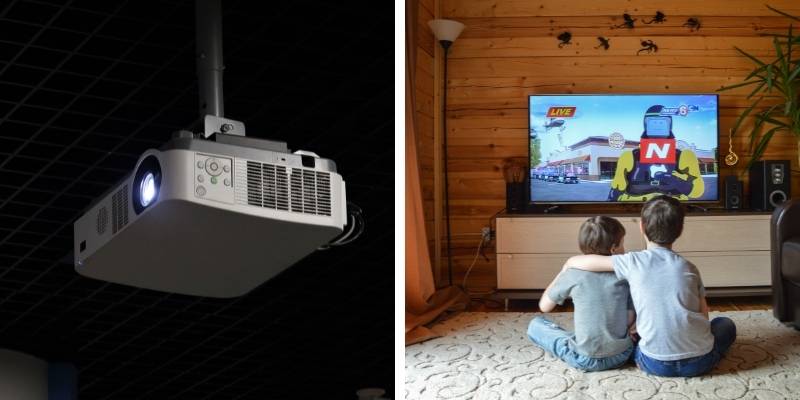Can not decide between projectors and OLED? It is important to know the difference between the two as well as your entertainment preferences to get to the final decision.
Projectors and modern TVs are better than each other in a lot of aspects. Projectors are used for larger-than-life projections on screens bigger than HDTVs.
Projectors and OLED TVs need to be compared to each other in terms of size and quality to see who wins the race.
Before heading over to the projector vs OLED debate, know these two devices separately first.
What is a Projector?
In the earlier days, it was referred to as a magic lantern. This optical device is capable of projecting onto a screen as big as a wall.
It is the best bet when it comes to projecting videos for a wider audience.
There are several types of projectors made for cinemas, bedrooms, home theaters, and office use.
What is OLED?
OLED or Organic Light Emitting Diode technology is the future of flatscreen TVs and computer monitors.
These TVs are a little different than LCD and LED models. Most OLED TVs have 4K quality, having 8,294,400 pixels.
However, the pixels look better than 4K television as when fed power, each pixel lights itself instead of relying on an LED backlight.
Difference Between Projector and OLED
| Projectors | OLED |
|---|---|
| Average 200 Inches | Average 80 Inches |
| Less Bright | More Bright |
| Up to 4k Resolution | Up to 8k Resolution |
| Need Extra Speaker for Audio | Built-in Speakers and Sound |
| Need Space for Installation | A wall mount required |
| Wide Color Gormut | Color spectrum depending on price |
| Almost 2000$ Cost | Average 3000$ Cost |
Certain questions hit you the most when setting up a home theater for quality entertainment.

If you are struggling to choose between these two options, this comparison would help you make a better choice.
Size
Projectors are an easy solution when it comes to having an ultra-large screen in your home.
Projectors are affordable in comparison with large-sized TVs. Generally, the rear projection size supported by the projectors is up to 200 inches.
Though the gap is narrowing in response to size, now we can get an OLED TV as big as 85″. However, these large-sized TVs may cost more than $3000.
Winner – Projectors
Contrast
It is the difference between brightness and black levels.
The brightness of the projector can be determined by the number of lumens, however, black levels can not be controlled by the device itself.
With projectors, the room needs to be completely darkened to get a better outcome.
OLED TV wins this round as it can easily heighten perceived contrast even in ambient light. These TVs handle the lighting and contrast situation better.
Winner – OLED
Brightness
Projector brightness is greatly influenced by the room lights and the lumen rating. The picture is usually washed out if the projector has insufficient brightness.
The price of ultra-bright projectors is quite high. Some modern light adjustment projectors are also used in baby sleeping.
A $1000 OLED TV has a much higher brightness than the projector. They offer a brighter display even in ambient lighting or during daylight hours.
A budgeted OLED produces higher brightness than expensive projectors. Unlike projectors, the brightness of an OLED TV is measured in nits.
Winner – OLED
Resolution
Projectors having 1080P or 4K resolution cost higher, nearly $2000. However, if you prioritize resolution over anything, opt for OLED.
You can get a high-powered OLED TV having the best 4K resolution with HDR and a wide color gamut at the aforementioned price.
Unlike projectors, 8K OLED TVs exist to deliver a clear and crisp picture.
Winner – OLED
Audio
Projectors are not known for better sound quality, oftentimes, you have to plug in extra speakers to get louder, room-filling audio.
OLED TV wins this easily by a large landslide as the high-quality TV handles the basic audio needs quite efficiently.
Winner – OLED
Color Accuracy
Projectors produce decent colors without needing you to spend an arm or a leg. DLP, LCD, 3-chip, or LCOS have a wider color gamut for producing authentic colors.
TVs require better processing to produce excellent colors. 4K OLEDs with HDR do a better job but can be costly.
Winner – Draw
Installation
A lot goes into installing a projector such as finding the right location to get a better display, painting a wall or buying a screen, routing HDMI cables, and keeping at the perfect distance.
Even if you choose the wall-mounted setup, you can do the installation yourself without getting any help from the installer most of the time.
Ease of Use
It is kind of apparent that projectors are less convenient than OLEDs. They need a particular environment, set up, and lighting conditions to provide better output. The projector bulb also needs to be replaced and becomes dim with time.
Many OLED TVs come loaded with smart features like a variety of apps, voice activation, streaming services, and so on. You can connect most of the projectors with Bluetooth like Epson.
They are easier to install and provide better quality pictures at an affordable price.
Winner – OLED
The electricity Consumption of projectors and OLED is almost the same.
Both OLED and projectors’ impact on eyes and health are the same.
Projector or OLED – What’s the Better Option?
It is evident from the above discussion that OLED TVs are better and convenient in nearly all aspects. Both options have their own pros and cons, while projectors add a glorious touch to the home, OLED is the future of TV.
Projectors give you cinematic experiences at home, do not rule them out yet, think about your preferences, and then decide.
In the end, it all comes down to personal preferences and tastes.
When comparing the two, OLED-tech TVs are better in a lot of aspects but that does not make the projector a loser.
Projectors beat out TVs in terms of size to serve a larger audience.
Both of these devices compensate for their deficits in a variety of ways. Consider your needs, requirements, and budgets to decide which would be a better appliance for you.
Read also: Cinemark Vs AMC
